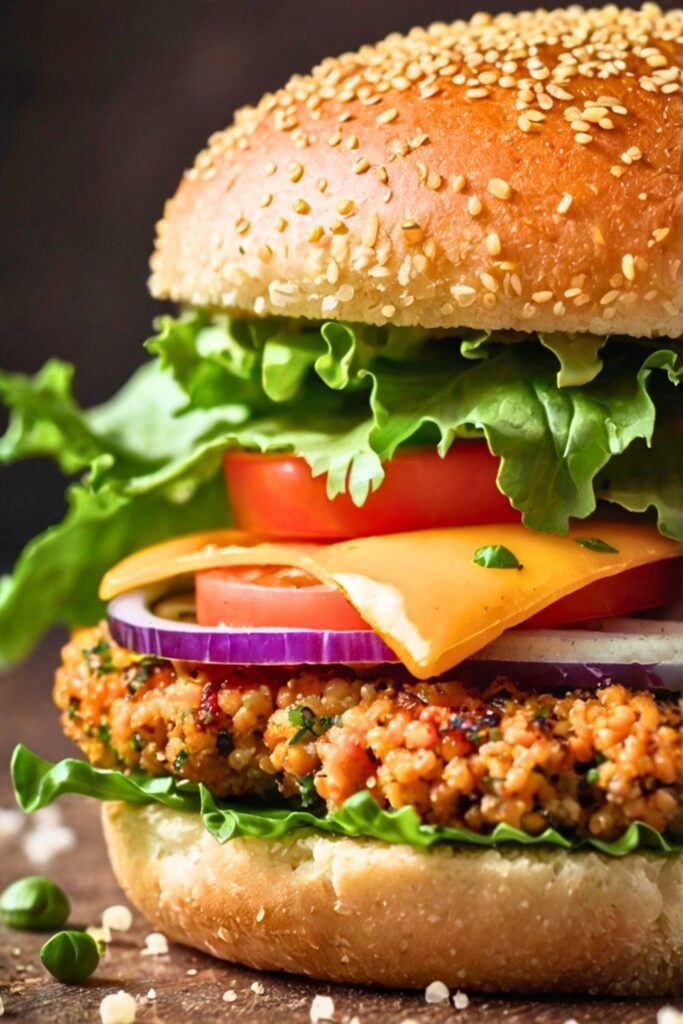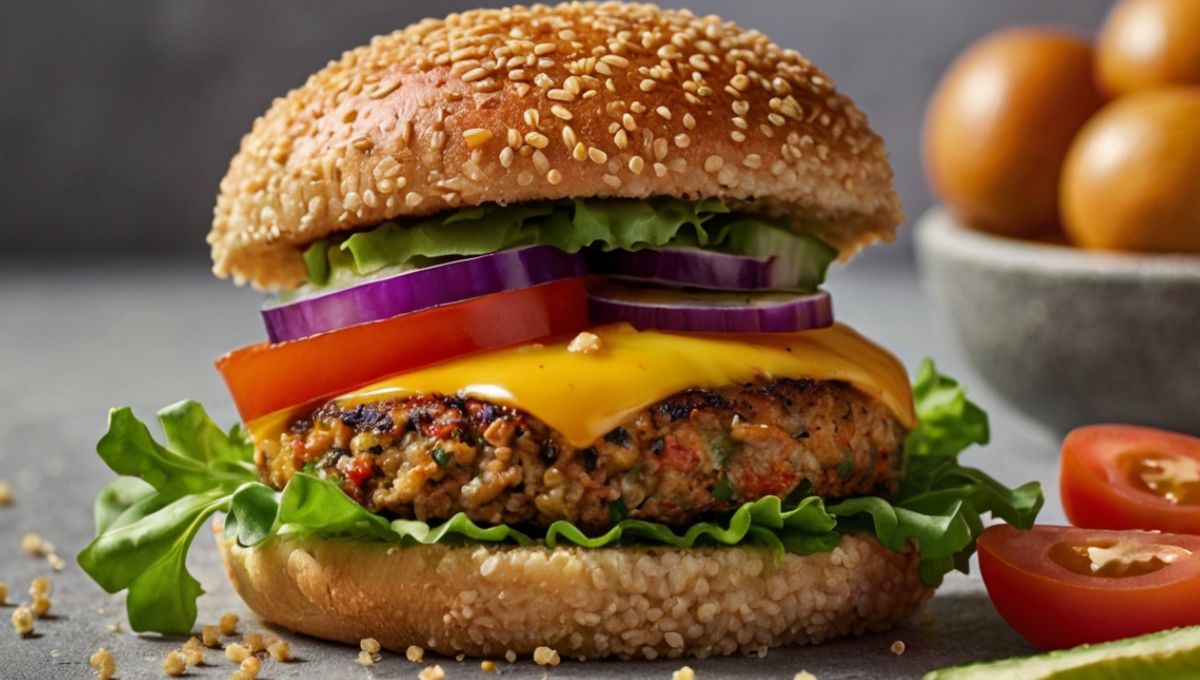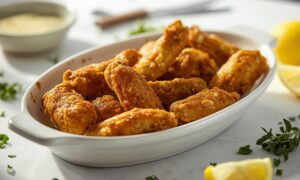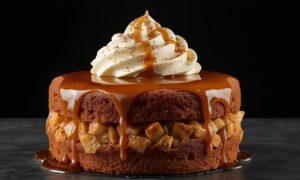When GrainShift Foods launched their quinoa burger line in 2020, analysts predicted failure. Three years later, they’re in over 2,000 specialty stores and raised $17 million. Their success stems from a formulation that highlights quinoa’s culinary potential rather than mimicking beef.
I tested their Andean Quinoa Patty during my consultancy days. After 18 months of development, the culinary director aimed for a burger so good that diners forget about meat. I was skeptical, but after tasting it, I was sold.
Exceptional quinoa burgers mark a shift in plant based thinking. They proudly showcase quinoa’s nutritional benefits, offering craveable flavors and textures. These dishes celebrate plant based ingredients, providing nutty profiles and culinary versatility that earn them spots on both casual and fine dining menus.
Ingredients & Substitutions
The foundation of an extraordinary quinoa burger begins with careful ingredient selection. Each component plays a crucial role in the final product’s texture, flavor, and structural integrity.
The Core Foundation
- Quinoa (1½ cups cooked): The star ingredient brings protein and a slightly crunchy texture. White quinoa works best for binding, but red or black varieties add visual interest and stronger flavor. Always rinse quinoa thoroughly before cooking to remove its natural bitter coating called saponin.
- Binding agents (2 eggs or flax eggs): These prevent crumbling during cooking. For vegan versions, 2 tablespoons ground flaxseed mixed with 6 tablespoons water and left to gel for 15 minutes creates a reliable substitute that actually improves the nutritional profile.
- Textural elements (½ cup breadcrumbs): Panko creates lighter burgers, while traditional breadcrumbs yield denser results. Oats processed into coarse flour make an excellent gluten free alternative with added fiber and nutty flavor.
Flavor Builders
- Aromatics (1 medium onion, 3 garlic cloves): Yellow onions provide sweetness when sautéed until translucent, while shallots offer a more delicate profile. Red onions add color and sharper bite. Fresh garlic is irreplaceable, but roasted garlic paste creates a deeper, more mellow flavor profile.
- Umami enhancers (2 tablespoons tomato paste, 1 tablespoon soy sauce): These ingredients add depth and savory qualities that make quinoa burgers satisfying. Miso paste makes an excellent soy sauce alternative with probiotic benefits, while mushroom powder creates incredible depth for those with soy allergies.
- Herbs and spices (1 tablespoon each: cumin, smoked paprika, fresh herbs): The spice blend can pivot toward any culinary tradition. Mediterranean versions excel with oregano and thyme, while Southwest profiles benefit from chili powder and cilantro. Fresh herbs always outperform dried in this application.
Textural Add ins
- Beans or legumes (1 cup black beans or chickpeas): These add protein, binding strength, and substance. Black beans create a more “meaty” appearance, while chickpeas contribute a lighter profile with excellent creaminess when partially mashed.
- Vegetables (½ cup each: bell pepper, corn, grated carrot): These add moisture, nutrition, and visual appeal. Root vegetables should be grated and lightly squeezed to remove excess moisture. Corn kernels provide pleasant bursts of sweetness and texture.
- Nuts or seeds (¼ cup walnuts, sunflower seeds, or pepitas): These add healthy fats, protein, and pleasant textural contrast. Toast them lightly before incorporating for maximum flavor development.
Step by Step Instructions
Creating exceptional quinoa burgers requires attention to technique. The process isn’t complicated, but certain steps are absolutely essential for success.
Preparation Phase
Begin by cooking 3/4 cup dry quinoa according to package directions, but substitute vegetable broth for water to infuse additional flavor. Spread the cooked quinoa on a baking sheet to cool completely. Hot quinoa cooks the eggs too early, resulting in gummy patties. Meanwhile, drain and rinse canned beans thoroughly, then pat them dry to prevent excess moisture from compromising your burger’s structure.
In a skillet over medium heat, sauté diced onions until translucent (about 5 minutes), then add minced garlic and cook for 30 seconds more. This crucial step eliminates the harsh bite of raw alliums while developing sweetness. Let this mixture cool completely before proceeding.
Mixing & Forming
In a large bowl, combine the cooled quinoa, cooled aromatics, and remaining ingredients except breadcrumbs. Use a potato masher or fork to partially mash about 70% of the beans, leaving 30% whole for textural contrast. Overprocessing creates a paste like consistency that lacks the pleasant mouthfeel we’re after.
Add breadcrumbs gradually while mixing with your hands. You’ll know you’ve reached the right consistency when the mixture holds together when squeezed but still feels somewhat moist. If it’s too wet, add more breadcrumbs; if too dry, introduce a splash of broth or olive oil. Let the mixture rest for 15-20 minutes to allow the breadcrumbs to absorb moisture and the flavors to meld.
With slightly damp hands (this prevents sticking), form patties approximately 3/4-inch thick and 4 inches in diameter. Press firmly to ensure compaction, and create a slight dimple in the center with your thumb. This prevents the common “puffing” problem during cooking. Place formed patties on a parchment lined sheet and refrigerate for at least 30 minutes, or up to 24 hours. You must not skip the resting stage; it hydrates starches and binds proteins, which dramatically improves structural integrity.
Cooking Methods
Quinoa burgers can be prepared through multiple cooking techniques, each offering distinct advantages:
Pan-frying: Heat 2 tablespoons high heat oil in a non stick skillet over medium heat. Cook patties for 4-5 minutes per side until deeply golden. This method creates the crispiest exterior but requires careful handling during flipping. Use a thin, flexible spatula and decisive movement to prevent breakage.
Baking: Preheat oven to 375°F (190°C). Brush patties lightly with oil and bake for 15 minutes, carefully flip, then continue baking for another 10-15 minutes. While this method involves less hands on attention, it doesn’t develop the same flavorful crust as pan frying.
Grilling: Freezing patties for 20 minutes before grilling and using a well oiled grill grate are absolute musts. Cook covered on medium heat for 5 minutes per side. The flavor development is unmatched, but this method requires the most skill to prevent patties from falling through the grates.
Regardless of cooking method, resist the urge to move the patties prematurely. Allow them to develop a proper crust before attempting to flip this is critical for structural integrity. Internal temperature should reach 165°F (74°C) for versions containing egg.
Cooking Techniques & Science

The secrets to exceptional quinoa burgers lie not just in the ingredients but in understanding the scientific principles at work behind them.
The Binding Matrix
Quinoa burgers lack the natural binding agents found in meat (myosin proteins and collagen), so we must create alternative protein networks. The starches in quinoa and beans form a complex matrix when combined with proteins from eggs or flax. This binding becomes significantly stronger when the mixture rests enzymatic activity begins breaking down some starches into sugars that create stronger bonds during cooking.
When cooking quinoa for burgers, aim for slightly overdone rather than perfectly fluffy. The additional starch release actually improves binding power significantly. Similarly, slightly overprocessing a portion of the beans releases more starch and protein, enhancing structural integrity.
Texture Optimization
The Maillard reaction, the chemical process that creates browned, flavorful surfaces, occurs most effectively in protein rich foods at temperatures above 300°F (149°C). For quinoa burgers, this means ensuring your cooking surface is properly preheated and patties are relatively dry on the surface. A light dusting of additional breadcrumbs or flour before cooking accelerates browning and creates a more satisfying crust.
Managing moisture poses the greatest challenge in veggie burger cookery. During cooking, vegetables release water and may affect texture. Pre cooking high moisture ingredients like mushrooms, spinach, or zucchini and then thoroughly squeezing out excess liquid prevents the dreaded soggy center. Similarly, salting grated vegetables and letting them drain for 15 minutes before squeezing removes considerable moisture.
Flavor Development
Umami, that elusive “fifth taste” that creates satisfaction and depth, is naturally lower in plant foods than in meat. Strategic incorporation of glutamate rich ingredients compensates brilliantly. Beyond tomato paste and soy sauce, nutritional yeast, sun dried tomatoes, aged cheeses (for non vegan versions), and mushroom powder all contribute significant umami without overwhelming the burger’s flavor profile.
Fat distribution plays a crucial role in flavor perception and mouthfeel. Unlike meat burgers where fat is naturally marbled throughout, plant based burgers benefit from manually distributed fat sources. Finely chopped nuts, seeds, or even carefully incorporated olive oil creates pockets of richness that burst during chewing, mimicking the sensation of animal fat.
Serving & Pairing Suggestions

A quinoa burger deserves accompaniments that complement its sophisticated flavor profile while maintaining its wholesome character.
The Perfect Bun
The ideal vessel should provide structure without overwhelming. Whole grain buns offer nutritional alignment and robust flavor, while pretzel buns contribute delightful chewiness and visual appeal. For gluten sensitive diners, portobello mushroom caps create elegant “bun less” presentations, and sturdy lettuce varieties like Bibb or iceberg provide refreshing crunch.
Traditional burger condiments often overwhelm quinoa’s subtle nuttiness. Instead, consider complementary spreads: avocado tahini sauce adds creaminess and healthy fats; harissa spiked yogurt brings probiotic benefits and gentle heat; roasted garlic aioli contributes luxurious mouthfeel without dairy.
Thoughtful Toppings
Move beyond standard lettuce and tomato with strategic topping selection. Quick pickled red onions contribute acidity and vibrant color. Microgreens add visual elegance and concentrated nutrition. Roasted red peppers provide sweetness and meaty texture. For non vegan versions, crumbled feta or goat cheese adds tangy complexity and improved mouthfeel.
Textural contrast elevates the eating experience immensely. Crispy elements like baked sweet potato strings, shaved radishes, or lightly fried shallots create memorable moments against the burger’s tender interior.
Inspired Side Dishes
Traditional fries certainly work, but why not extend the culinary creativity to sides? Roasted chickpeas seasoned with the same spice blend used in your burgers creates flavor continuity. Quinoa tabbouleh reinforces the grain’s presence while adding brightness. A simple kale salad with citrus vinaigrette cuts through the burger’s richness while complementing its health forward profile.
For beverage pairings, craft wheat beers complement nutty flavors beautifully, while sparkling water infused with herbs echoes aromatic elements. Unsweetened iced tea with citrus provides refreshment without competing with complex flavors.
Conclusion
The quinoa burger represents far more than a meat alternative it’s a culinary achievement worthy of celebration in its own right. By understanding the scientific principles behind binding, texture development, and flavor enhancement, chefs and home cooks alike can create plant based burgers that satisfy even the most dedicated carnivores.
The true art lies in balance: creating patties sturdy enough to withstand handling yet tender enough to provide pleasant mouthfeel; developing complex flavors without overwhelming quinoa’s delicate nuttiness; embracing healthy ingredients without sacrificing culinary pleasure. When executed thoughtfully, these burgers earn their place in the pantheon of great handhelds.
Whether you’re serving an upscale restaurant clientele, feeding a health conscious family, or simply exploring plant based cooking, mastering the quinoa burger opens doors to endless creativity. The techniques discussed here, moisture management, flavor layering, and textural optimization, apply broadly across plant based cooking, making this recipe a valuable addition to any culinary repertoire.
Frequently Asked Questions: Substitutes for Lemon Juice
Why Do My Quinoa Burgers Fall Apart During Cooking?
Your burgers likely lack proper binding. Use enough binding agents like eggs or flax eggs. If the mixture feels too wet, mix in more breadcrumbs. Most importantly, chill the patties in the refrigerator for at least 30 minutes before cooking. This resting time helps the ingredients firm up and stay together.
Can I Freeze Quinoa Burgers?
Yes, you can freeze them before cooking. Place parchment paper between each patty, then freeze in an airtight container. When you’re ready to use them, thaw in the fridge overnight or cook them straight from frozen. Just lower the heat and extend the cooking time by about 50%. Freezing the patties helps them hold their shape better on the grill.
How Can I Make My Quinoa Burgers More “Meaty”?
Add umami rich ingredients. Sautéed mushrooms (like portobellos or shiitakes), tomato paste, Worcestershire sauce (or coconut aminos), and smoked paprika all help create a deeper flavor. Use cooking methods like grilling or pan searing to build a rich, browned exterior that adds a “meaty” texture.
Is There a Trick to Getting Quinoa Burgers Crispy on the Outside Without Drying Them Out?
Yes—focus on surface prep and heat control. Lightly dust each patty with breadcrumbs or rice flour before cooking. Use enough oil to create even contact with the pan, and wait 4–5 minutes before flipping to let a crisp crust form. If baking, spray the patties lightly with oil to boost browning and crispiness.
How Do I Adjust the Flavors for Different Culinary Traditions?
Swap the seasonings while keeping the method the same. For Mediterranean style burgers, use oregano, lemon zest, feta, and olives. For a Southwest version, add black beans, corn, chipotle, and lime juice. Asian inspired patties work well with scallions, ginger, sesame oil, and miso paste. Adjust your spices to match the theme, but keep the base technique consistent.

Swiftly Captions by Tina Smith — Quick, flavorful food recipes made simple, bringing fresh inspiration to your kitchen every day






